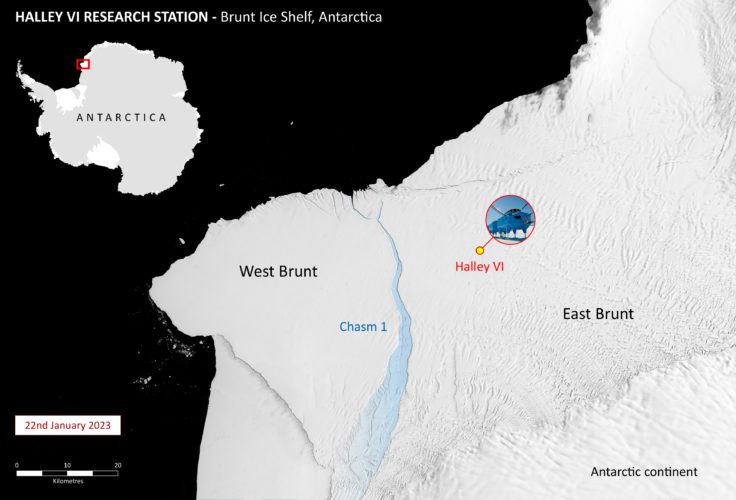A large iceberg “the size of Greater London” has broken off the Brunt Ice Shelf in Antarctica. The calving event on January 22 is believed to be fully natural and a long time coming. The British Antarctic Survey (BAS) has been documenting the crack for decades, and in 2016 even made the decision to pick up and move their research base 23 kilometers (14 miles) further inland to avoid danger, a wise move as it has now snapped off.
The Brunt Ice Shelf is 150 meters ( 492 feet) thick and the iceberg that calved from it has a surface area of 1,550 square kilometers (598 square miles). That it’s bigger than the area of cities like New York and Los Angeles, and only slightly smaller than London. The crack that caused the rupture was called Chasm-1, which became active again in 2012 after being dormant for 35 years.
After it began to widen over the following years, in 2016 the BAS decided to shift the Halley base 23 kilometers (14.3 miles) inland by basically putting it on skis and being towed by a tractor. The call to move it was indeed correct as now Chasm-1 has cut off the portion of the Ice Shelf the Halley VI research laboratory used to occupy.
The British Antarctic Survey’s previous Halley VI location was just about the t in “Brunt” on the iceberg. Image credit: BAS
“Our glaciologists and operations teams have been anticipating this event. Measurements of the ice shelf are carried out multiple times a day using an automated network of high-precision GPS instruments that surround the station,” Professor Dame Jane Francis, Director of BAS said in a statement.
“These measure how the ice shelf is deforming and moving, and are compared to satellite images from ESA, NASA and the German satellite TerraSAR-X. All data are sent back to Cambridge for analysis, so we know what is happening even in the Antarctic winter – when there are no staff on the station, it is dark for 24 hours and the temperature falls below minus 50 degrees C (or -58F).”
In 2021, the A-74 iceberg calved from the Brunt Ice Shelf, which is showing the cracks where the new iceberg will eventually break off. Image credit: Contains modified Copernicus Sentinel data (2021), processed by ESA, CC BY-SA 3.0 IGO
Calving events happen regularly although predicting the exact moment is not possible. Brunt seems to be less affected than the Larsen C Ice Shelf when it comes to the climate crisis and the team doesn’t believe that it played a significant role in this event.
“This calving event has been expected and is part of the natural behaviour of the Brunt Ice Shelf. It is not linked to climate change. Our science and operational teams continue to monitor the ice shelf in real-time to ensure it is safe, and to maintain the delivery of the science we undertake at Halley,” Professor Dominic Hodgson, BAS glaciologist, added.
The iceberg will be given an official name by the U.S. National Ice Center.
Source Link: Huge Iceberg Has Broken Free From Antarctic Ice Shelf At Last
